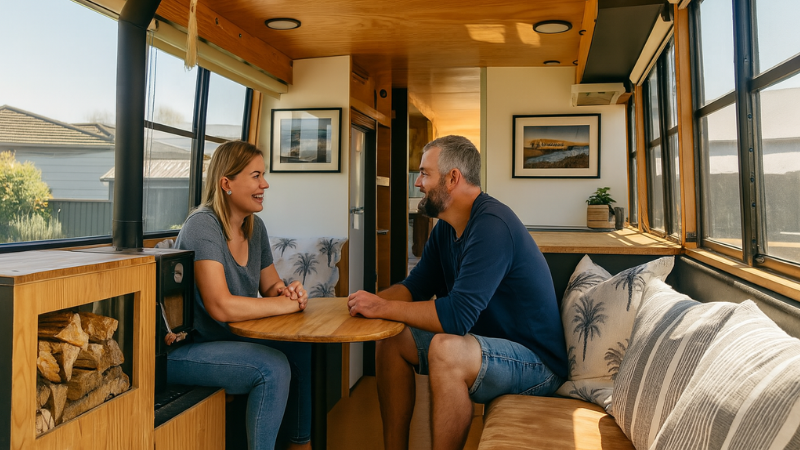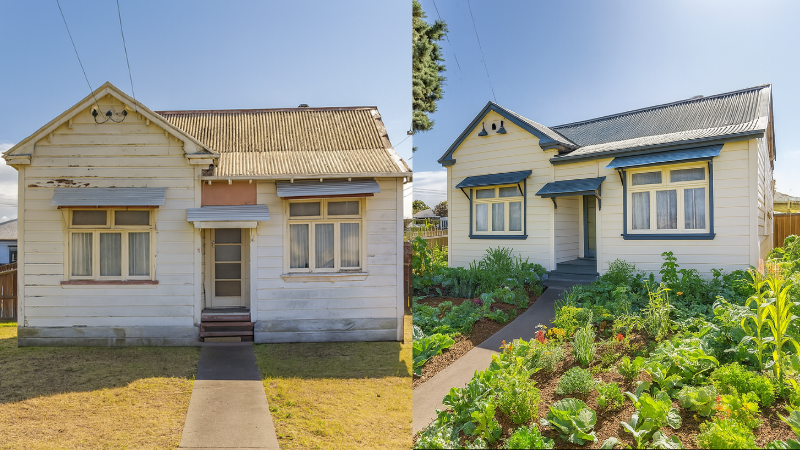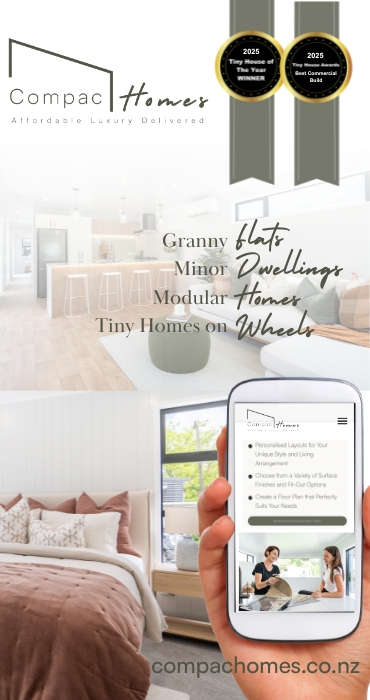How one couple’s offbeat decision gave them a future without debt.
When Amy and Josh first moved into their converted house bus in 2013, most people assumed it was a temporary thing. A bit of a laugh. A financial blip. Something to endure until they could get “a proper house” with “real walls.” They were 27 and 29 at the time, living in Whanganui, working full-time, and trying unsuccessfully to get onto the property ladder. “We were doing all the right things,” Amy says. “Paying rent, saving a little each month, looking at open homes. But we were getting nowhere. Prices kept creeping up, and our savings didn’t.” Then they stumbled across an ad in a local Facebook group: “House bus for rent. $100/week. Off-grid. Parking on a lifestyle block. Long-term preferred.”
They went to have a look, expecting something grim. Instead, they found a tidy, well-loved bus parked on a friend-of-a-friend’s property. It had a composting toilet, a rainwater collection tank, solar panels, and a woodburner. It was warm. Cosy. Quiet. The owner a semi-retired builder, had actually lived in the bus himself while building his main house on the land. For two years, it had been his full-time home while he worked on-site. Now that the big house was finished, the bus had become surplus. He was happy to lease it out for cheap and told Amy and Josh they could stay for as long as they liked. “He understood the struggle,” Josh says. “We were just at a different point in the same journey he’d already been on.” Financially, it was a game-changer
From the outside, the decision looked… unconventional. Amy’s coworkers teased her about showering outside in winter. Josh’s family assumed they’d run out of hot water and patience within a month. But they didn’t. In fact, once they adjusted to the smaller space and slower pace of off-grid living, things got easier. “We had more time. More money. Fewer things to worry about,” Amy says. “We cooked more. We read more. We finally got around to starting a vege garden.” Financially, it was a game-changer. At the time, they were earning a combined $95,000 a year. But instead of increasing their lifestyle, they slashed it. They decided to live off one income and save the other, treating the second wage like it didn’t exist. Their rent for the house bus was just $100 per week. Power came from solar. Water was free from the sky. Between reduced bills and a near-total lifestyle reset, they managed to put away around $60,000 per year. “We weren’t travelling or buying flash stuff,” Josh says. “But we didn’t feel deprived either. It was actually pretty satisfying, watching our savings grow.” After three years of disciplined saving, they’d built up $180,000 in cash. That was all the leverage they needed. They began casually looking at properties, not expecting much when they came across a weathered three-bedroom villa in Whanganui East. It had good bones, a sunny backyard, and a price tag that made them look twice.
“It needed work, but we saw the potential,” Amy says. “And for the first time, we were in a position to buy it outright.” They paid $140,000 in cash for the house, and used the remaining $40,000 to renovate. They replaced the roof, added insulation, painted throughout, and gave the tired kitchen and bathroom a refresh. “We walked into our first home without a mortgage,” Josh says. “And that’s all because of the decision we made to live small for a few years.” Amy and Josh both still work full-time, but not because they have to. “We could quit tomorrow and live on part-time income,” Josh says. “But we’re choosing to set ourselves up further, maybe for another property, or for travel, or just for options later.”
If you met Amy and Josh today, you’d never guess their story. They live in a warm, well-designed home. They grow most of their own veges. They have savings. No mortgage. No landlord. No regrets. But the path that got them there wasn’t glamorous. It wasn’t Instagram-perfect. It was three years of cold mornings and low ceilings. Learning to live with less. Of letting go of what people thought they should be doing, and following what made sense. “We always say living tiny wasn’t the end goal. It was the bridge,” Amy says. “It gave us the breathing room to get out of survival mode and start planning for the future.” Too often, the tiny house conversation gets stuck in aesthetics: cute spaces, clever storage hacks, minimalist style. Or it swings the other way, criticising tiny homes for being “too expensive per square metre” or “not a real solution.” But stories like Amy and Josh’s remind us that the power of tiny living lies in what it frees up, time, money, options, and momentum. A tiny home doesn’t have to be your forever home. But it might be the smartest thing you ever do on your way to whatever comes next.
Inspired by stories like this? We’re collecting real-life case studies of people who used tiny homes as a stepping stone to something bigger. If you’ve got a story like Amy and Josh’s, we’d love to hear it. Contact us



